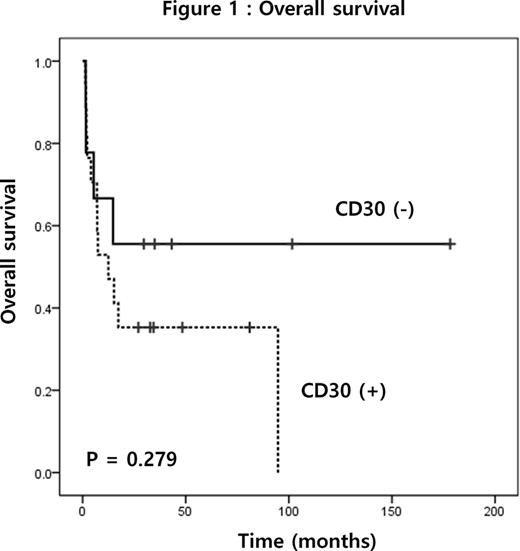Abstract
The prognostic impact of EBV-positivity in EBV-positive DLBCL of the elderly is controversial. Previous Asian studies have shown consistent poor prognostic impact of EBV-positivity. Recent Western study has shown no significant prognostic impact of EBV-positivity alone. However, the study found that CD30 and EBV co-expression is associated with an adverse outcome and suggested CD30 co-expression might be associated with different prognostic impact of EBV-positivity between Asian and Western populations.
We retrospectively analyzed 26 Korean patients with EBV-positive DLBCL of the elderly diagnosed at Samsung Medical Center and had adequate amount and quality of paraffin-embedded biopsy specimen for additional immunostaining of CD30. EBV RNA was detected by an ISH technique and a positive reaction was defined as more than 20% of examined cells showing nuclear positivity. Cell of origin was assigned using Hans immunohistochemical algorithm.
Prevalence of CD30 co-expression in EBV-positive DLBCL of the elderly was 65.4% (17/26) and 50.0% (13/26) using a >0% cut-off and a >30% cut-off, respectively. There was no statistically significant difference of survival between cases with CD30 co-expression and case without CD30 co-expression. However, the cases with CD30 co-expression showed a modest trend of worse overall survival (OS) (median OS, 12.5 months [95%CI 1.5-23.4] versus not reached, P = 0.279) and progression-free survival (PFS) (median PFS, 7.4 [95%CI 5.7-9.1] versus 34.2 months [95%CI 0.0-89.1], P = 0.430) using >0% cut-off. Among 17 patients with CD30 and EBV co-expression, most of patients (88%, 15/17) showed non-germinal center B-cell like (GCB) DLBCL.
Substantial proportion of Korean patients with EBV-positive DLBCL of the elderly showed CD30 co-expression. CD30 co-expression in EBV-positive DLBCL of the elderly showed a modest trend of an adverse outcomes without statistical significance. Further validation study with larger population is warranted. Considering previously known contradictory trend of better outcome in CD30 positive cases with EBV-negative and GCB type DLBCL, we also need to investigate the possible distinct pathobiology of CD30 positivity in EBV-positive DLBCL of the elderly.
No relevant conflicts of interest to declare.
Author notes
Asterisk with author names denotes non-ASH members.



This feature is available to Subscribers Only
Sign In or Create an Account Close Modal